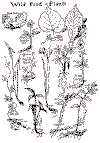by Ernest Thompson Seton
No one truly knows the woods until he can find with certainty a number of wild plants that furnish good food for man in the season when food is scarce; that is, in the winter or early spring.
During summer and autumn there is always an abundance of familiar nuts and berries, so that we may rule them out, and seek only for edible plants and roots that are available when nuts and berries are not.
Rock Tripe. The most wonderful of all is probably the greenish-black rock tripe, found on the bleakest, highest rocks in the northern parts of this continent. There is a wonderful display of it on the cliffs about Mohonk Lake, in the Catskills. Richardson and Franklin, the great northern explorers, lived on it for months. It must be very carefully cooked or it produces cramps. First gather and wash it as clear as possible of sand and grit, washing it again and again, snipping off the gritty parts of the roots where it held onto the mother rock. Then roast it slowly in a pan till dry and crisp. Next boil it for one hour and serve it either hot or cold. It looks like thick gumbo soup with short, thick pieces of black and green leaves in it. It tastes a little like tapioca with a slight flavoring of licorice. On some it acts as a purge.
Basswood Browse or Buds. As a child I ate these raw in quantities, as did also most of my young friends, but they will be found the better for cooking. They are particularly good and large in the early spring. The inmost bark also has food value; but one must disfigure the tree to get that, so we leave it out.
Slippery Elm. The same remarks apply to the buds and inner bark of the slippery elm. They are nutritious, acceptable food, especially when cooked with scraps of meat or fruit for flavoring. Furthermore, its flowers come out in the spring before the leaves, and produce very early in the season great quantities of seed which are like little nuts in the middle of a nearly circular wing. These ripen by the time the leaves are half grown and have always been an important article of food among the wild things.
Many Indian tribes used to feed during famine times on the inner bark of cedar and white birch, as well as on the inner bark of the slippery elm and basswood, but these cannot be got without injury to the tree, so omit them.
When the snow is off the ground the plants respond quickly, and it is safe to assume that all the earliest flowers come up from big, fat roots.
A plant can spring up quickly in summer, gathering the material of growth from the air and soil, but a plant coming up in the early spring is doing business at a time when it cannot get support from its surroundings, and cannot keep on unless it has stored up capital from the summer before. This is the logic of the storehouse in the ground for these early comers.
Wapato. One of the earliest is wapato, or duck potato, also called common Arrowleaf, or Sagittaria. It is found in low, swampy flats, especially those that are under water for part of the year. Its root is about as big as a walnut and is good food, cooked or raw. These roots are not at the point where the leaves come out but at the ends of the long roots.
Bog Potato. On the drier banks, usually where the sedge begins near a swamp, we find the bog potato, or Indian potato. The plant is a slender vine with three, five, or seven leaflets in a group. On its roots in spring are from one to a dozen potatoes, varying from an inch to three inches in diameter. They taste like a cross between a peanut and a raw potato, and are very good cooked or raw.
Indian Cucumber. In the dry woods one is sure to see the pretty umbrella of the Indian cucumber. Its root is white and crisp and tastes somewhat like a cucumber, is one to four inches long, and good food raw or boiled.
Calopogon. This plant looks like a kind of grass with an onion for a root, but it does not taste of onions and is much sought after by wild animals and wild people. It is found in low or marshy places.
Hog Peanuts. In the early spring this plant will be found to have a large nut or fruit, buried under the leaves or quite underground in the dry woods. As summer goes by the plant uses up this capital, but on its roots it grows a lot of little nuts. These are rich food, but very small. The big nut is about an inch long and the little ones on the roots are any size up to that of a pea.
Indian Turnip or Jack-in-the-Pulpit. This is well known to all our children in the East. The root is the most burning, acrid, horrible thing in the woods when raw, but after cooking becomes quite pleasant and is very nutritious.
Prairie or Indian Turnip, Bread-root or Pomme-blanche of the Prairie. This is found on all the prairies of the Missouri region. Its root was and is a staple article of food with the Indians. The roots are one to three inches thick and four to twelve inches long.
Solomon's Seal. The two Solomon's Seals (true and false) both produce roots that are long, bumpy storehouses of food.
Crinkle-Root. Every school child in the country digs out and eats the pleasant peppery crinkle-root. It abounds in the rich, dry woods.
